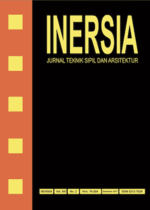Spatial Patterns of Nomad Tourism in Canggu Village Bali
DOI:
https://doi.org/10.21831/inersia.v20i2.73224Keywords:
Nomadic Tourism, nomad tourist behavior, spatial patterns of Nomadic TourismAbstract
Nomadic Tourism has emerged as a new trend after the Covid-19 pandemic. This tourism style involves travellers moving around and staying for certain periods in destinations that offer easily movable amenities. Canggu Village in Bali has become one of the world's most popular destinations for nomadic tourists, ranking eighth based on reviews from the nomad tourist community. In Canggu Village, nomadic tourists form spatial patterns influenced by their behaviour, types of travel, and travel patterns. This research aims to identify the behaviour of nomadic tourists in Canggu Village, Bali, and to describe the spatial patterns of Nomadic Tourism in the area. The research employs a descriptive qualitative approach, utilising methods such as observation, interviews, and documentation. The findings reveal insights into the behaviour of nomadic tourists and provide a detailed description of the spatial patterns of Nomadic Tourism in Canggu Village, Bali.
References
Kemenparekraf RI (2023). Buku Tren Pariwisata 2022-2023, 25-36
Prabawa, I. W. S. W., Pertiwi, P. R. (2020) The Digital Nomad Tourist Motivation in Bali: Exploratory Research Based on Push and Pull Theory
Kemenparekraf RI (2021), "Digital Nomad, Tren Pariwisata di Indonesia"
Haking, J (2017) Digital Nomad Lifestyle, a Field Study in Bali
Mahadewi, N. M. E. (2018) Nomadic Tourism, Wisata Pendidikan, Digitalisasi dan Wisata Event dalam Pengembangan Usaha Jasa Akomodasi Homestay di Destinasi Wisata
Shita, G. (2021) Mengenal Nomadic Tourism
Laksmi, G. W., Rahmanita, M., Brahmantyo, H., Nurbaeti (2021) SWOT Analysis Nomadic Tourism as Millennial Friendly Natural Tourist Destination Development Strategy (Case Study: Glamping de Loano, Purworejo)
Kemenparekraf RI (2021) Digital Nomad, Tren Pariwisata di Indonesia
Mouratidis, G. (2015) Digital Nomadism
Lue C. C., Crompton J. L., Fesenmaier, D. R. (1993) Annals of Tourism Reseach: Conseptualization of Multi-Destination Pleasure Trips. USA: Elsevier. Volume 2, Issue 2, 289-301
Lau, G., McKercher, B. (2006) Understanding Tourist Movement Patterns in a Destination: A GIS Approach. Sage Publications. Volume 7, No. 1, 39-49
Komsary, K. C. (2016) Glosari Sumber dan Daya Tarik Wisata
Wahyundaria, D. A., Sunarta, I. N. (2020) Identifikasi Dampak Perkembangan Pariwisata terhadap Lingkungan di Desa Canggu, Kecamatan Kuta Utara, Kabupaten Badung
Oceams (2020), Kejuaraan Selancar Nasional Indonesia Lengkapi Aceh, Bali dan Jawa Barat Raih Medali Terbanyak
BPS Kab. Badung (2022), Kecamatan Kuta Utara dalam Angka 2022. Badung: CV. Bhineka Karya. 95
Moelong, L. J. (2018) Metode Penelitian Kualitatif
Downloads
Published
How to Cite
Issue
Section
License
Authors who publish with INERSIA journal agree to the following terms:
- Authors retain copyright and grant the INERSIA journal right of first publication with the work simultaneously licensed under Creative Commons Attribution License (CC BY 4.0) that allows others to share the work with an acknowledgment of the work's authorship and initial publication in this journal.
- Authors can enter into separate, additional contractual arrangements for the non-exclusive distribution of the published version of the work (e.g., post it to an institutional repository or edit it in a book), with an acknowledgment of its initial publication in this journal.
- Authors are permitted and encouraged to post their work online (e.g., in institutional repositories or on their website) before and during the submission process, as it can lead to productive exchanges, as well as earlier and greater citation of published work.

INERSIA by https://journal.uny.ac.id/index.php/inersia was distributed under a Creative Commons Attribution 4.0 International License







